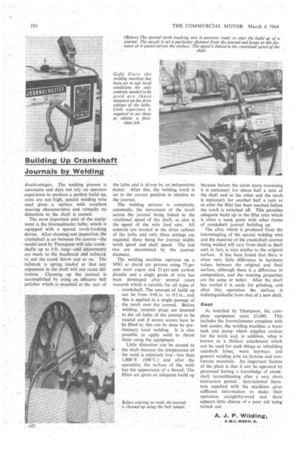Building Up Crankshaft Journals by Welding
Page 106

If you've noticed an error in this article please click here to report it so we can fix it.
disadvantages. The welding process is automatic and does not rely on operator experience to produce a perfect build up, costs are not, high, special welding wire used gives a surface with excellent wearing characteristics and virtually no distortion to the shaft is caused.
The most important part of the equipment is the Joumalniaster lathe, which is equipped with a special torch-tracking device. After cleaning and inspeCtion, the crank-shaft is set between the centres—the model used by Thompson will take crankshafts up to 8 ft. long—and adjustments are made to the headstock and tailstock to suit the crank throw and so on. The tailstock is spring loaded so that any expansion in the shaft will not cause distortion. Cleaning up the journal is accomplished by using an abrasive belt polisher which is mounted at the rear of the lathe and is driven by an independent motor. After this, the welding torch is set to the correct position in relation to the journal.
The welding process is completely automatic, the movement of the torch across the journal being linked to the rotational speed of the shaft, as also is the speed of the wire feed unit:, All controls are located in the drive cabinet of the lathe and only three settings are required; these being for journal width, torch speed and shaft speed. The last two are determined by the journal diameter.
The, welding machine operates on a MEG or shield arc process using 75 per
cent inertargon and 25 per cent carbon
dioxide and a single grade of wire has been developed after several years research which is suitable for all types of
crankshaft. The amount of build up can be from 0-08 in. to 0-2 in., and this is applied in a single passage of the torch over the journal. Before welding. ceramic plugs are inserted in the oil holes of the journal to be treated and if severe scores have to be filled in, this can be done by preliminary local welding. It is also .. possible to apply weld to .thrust faces using the equipment.
Little distortion can be caused to the shaft because the temperature -of the weld is relatively low—less than 1,000°F. (540°C.) and after the operation, the surface of the weld has the appearance. of a thread. The fillets are given an adequate build up
because before the torch starts traversing it is stationary for about half a turn of the shaft and at the other end the torch is stationary for another half a turn or so after the fillet has been reached before the torch is switched off. This provides adequate build up in the fillet area which is often a weak point with other forms of crankshaft journal building up.
The alloy which is produced from the intermingling of the special welding wire and the material of the crankshaft journal being welded will vary from shaft to shaft and, in fact, is very similar to the original surface. It has been found that there is often very little diffeience in hardness values between the original and final surface, although there is a difference in composition, and the wearing properties are the same or better. After the shaft has cooled it is ready for grinding,and after this operation the surface is indistinguishable from that of a new shaft.
Cost
As installed by Thompson, the complete equipment costs 0,600. This includes the Journalmaster complete with belt sander, the welding machine, a water tank and pump which supplies coolant for the torch and, in addition, what is known. as a, Heliarc attachment which can be used for such things -as rebuilding camshaft lobes, worn keyways and general welding jobs onferrous and nonferrous materials. An important feature of the plant is that it can be operated by personnel"having a knowledge of crankshaft reconditioning after a very short instruction period. • Instructional literature supplied with the machines gives sufficient information tomake their operation straightforward and there appears little chance of a poor job being turned out.




































































































































































